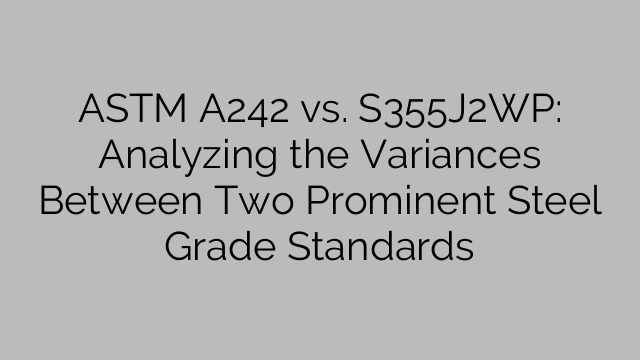Steel is a vital material in various industries, including construction, shipbuilding, and manufacturing. It provides strength and durability to structures, ensuring their longevity and safety. To ensure consistent quality and performance, different steel grade standards have been established. In this article, we will analyze the variances between two prominent steel grade standards: ASTM A242 and S355J2WP.
ASTM A242 is a specification for high-strength low-alloy structural steel with improved atmospheric corrosion resistance. It is commonly used in structural applications such as buildings and bridges. On the other hand, S355J2WP is a European standard for weathering steel with similar corrosion-resistant properties.
Corrosion resistance is a crucial factor when selecting steel for outdoor applications. Both ASTM A242 and S355J2WP offer enhanced resistance to atmospheric corrosion compared to regular carbon steel. They contain alloying elements like copper, chromium, nickel, and phosphorus, which form a protective layer on the steel’s surface, preventing further corrosion.
One of the significant differences between these steel grade standards lies in their chemical composition. ASTM A242 primarily consists of copper, while S355J2WP incorporates copper, phosphorus, silicon, manganese, and chromium. The presence of these alloying elements enhances the corrosion resistance of the steel and provides structural stability.
Another vital aspect to consider is the mechanical properties of the steel grades. ASTM A242 has specified minimum yield and tensile strengths of 50 ksi (345 MPa) and 70 ksi (480 MPa), respectively. It is characterized by excellent weldability, formability, and machinability, making it suitable for various applications.
S355J2WP, on the other hand, has a minimum yield strength of 355 MPa and a minimum tensile strength of 510-680 MPa. It exhibits improved atmospheric corrosion resistance due to its alloying elements. Additionally, S355J2WP has excellent cold-forming properties and can be welded without any preheating or post-weld heat treatment.
When it comes to available shapes and forms, ASTM A242 offers a wide range of options. It can be obtained in plates, bars, and shapes, making it versatile for different structural applications. S355J2WP is primarily available in plates and sheets.
In terms of certifications, ASTM A242 is compliant with the ASTM International standards, ensuring its adherence to specific quality and performance requirements. S355J2WP conforms to the European standard EN 10025-5, which guarantees its compliance with European industry specifications.
While both ASTM A242 and S355J2WP offer corrosion resistance and high-strength properties, the choice between them depends on various factors. Project location, budget, and specific design requirements should be considered when selecting the appropriate steel grade. Simultaneously, it is important to consult with steel suppliers or experienced professionals to ensure the proper selection based on the project’s needs.
In conclusion, ASTM A242 and S355J2WP are two prominent steel grade standards known for their enhanced atmospheric corrosion resistance. While ASTM A242 is a specification formed by ASTM International, S355J2WP adheres to the European standard EN 10025-5. The chemical composition, mechanical properties, and available forms vary between the two standards. Therefore, it is crucial to analyze project requirements and consult with experts to select the most suitable steel grade for each application.

